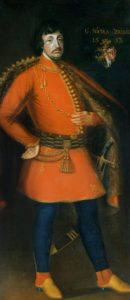1663: The victories of Zrínyi Miklós, and Zrínyi Péter’s
10 October 1663: Zrínyi Miklós defeated the Ottomans at Vízvár
During the siege of Érsekújvár (1663), a noble insurrection was called. The Transdanubian troops were mustered on Monday 17 September near Vat (Merseva) in Vas County, together with the Croatian troops under the leadership of Zrínyi Miklós, the Croatian-Slavonian Ban. The surrender of Érsekújvár Castle (Nové Zámky) took place at the end of September 1663 and it caused a serious breach on the Hungarian chain of Borderland castles against the Ottoman Empire.

Taking an adventure of the new success, Grand Vizier Köprülü Achmed offered to the Hungarian Noble Estates that the new Hungarian Kingdom could be organized, under the lead of Prince Apafi Mihály of Transylvania. (Note: the Transylvanian Principality was a vassal state of the Sultan but enjoyed such privileges that were unheard of in the Ottoman Empire.)

However, the Hungarian aristocrats of Royal Hungary didn’t react to this. Rather, they stubbornly resisted the Ottoman expansion. Zrínyi Miklós (Nikola Zrinski), the newly appointed chief commander of the Hungarian military forces immediately attacked the Turks in the South-Trans Danubian Region and on the lands of Lower Hungary as it was already too late to relieve the siege of Érsekújvár.

Zrínyi marched against the smaller Turkish units ravaging the area. His first victory was at Vízvár Castle on 10 October where he defeated a smaller Ottoman army.
On October 10, at Vízvár in Csallóköz in Lower Hungary, the 15,000-strong united Christian army (joined by two German regiments) ambushed and defeated the Turkish rearguard. According to Esterházy Pál, 600 Turks were killed in the battle, while the Hungarians suffered only 12 casualties. Many prisoners were taken and the booty was considerable.

This is what Pál Esterházy wrote about it in his work, the “Mars Hungaricus”:



11 (or 17) October 1663: Zrínyi Péter defeated the Ottomans at Károlyváros (Karlovac)
In the meantime, his younger brother Zrínyi Péter aka Petar Zrinski repelled the attack of Pasha Csengics of Bosnia who wanted to take Zrínyi-Újvár Castle. Moreover, Péter (or Petar) pursued him and defeated the Pasha at Otocsác, near Károlyváros Castle (Karlovac) on 11 (or 17?) October 1663.
The Bosnian Pasha had originally about 6,000 Turk and Crimean Tartar troops in his army but he lost 1,000 of them. Zrínyi Péter collected a great bounty and 8 Ottoman flags.
According to Lord Esterházy Pál, even a pasha was captured. He wrote: „… honorable Lord Count Zrínyi Péter assaulted the Bosnian Turks hard and captured a pasha, cutting down more than a thousand of the enemy while the rest were fleeing hastily. He has returned home, bringing numerous flags which were later offered to His Majesty in Vienna…”

27 November 1663: The victory of the Zrínyi / Zrinski brothers at the castle of Zrínyi-Újvár (Novi Zrin)
Zrínyi Miklós alias Nikola Zrinski and his brother Péter (Petar) set out from the Csallóköz area (between Pozsony / Pressburg / Bratislava and Vienna / Bécs / Wien) and soon arrived at the castle of Zrínyi-Újvár (Novi Zrin) in the South-Transdanubian region, at the confluence of the Mura and Dráva rivers, where they defeated a combined army of Turks and Crimean Tatars who wanted to take the newly built fortress.

The enemy had set out to take it with a large army and proper military engineers and bridge builders. They based their strategy on a quick crossing of the Mura River in a surprise attack. In fact, the Crimean Tartars were able to establish a bridgehead on the opposite bank. That was when Zrínyi arrived and pushed them into the river. But this did not stop the Turkish attacks, and the battle raged on throughout the night. Eventually, the Ottoman troops gave up their attacks and the Zrínyi brothers gained ground, driving the enemy away.

The castle system of the Hungarian Borderland was severely damaged in 1663 when the Ottomans captured Érsekújvár Castle (Nové Zámky) in the north. The Turks seem to have found their way into the rich Mining District because Érsekújvár Castle was its central stronghold. Nevertheless, Zrínyi Miklós and Péter defeated several smaller and larger Ottoman forces at the castles of Vízvár, Károlyváros (Karlovac) and Zrínyi-Újvár. These victories could not be compared to the heavy loss of Érsekújvár, but they helped to maintain the spirit of resistance.

Practically, the brothers were annihilating the rest of the scattered Ottoman army along the Mura River. Miklós returned to the Muraköz (Mura River Region) area only at the end of November. Zrínyi took these victories into account when he set out on his victorious winter campaign a year later, in 1664, paving the way for the combined forces of a Christian coalition, not knowing that such an alliance would not be formed until 1683, under the leadership of the Habsburgs.

I note that Miklós died in a hunting accident in 1664 and his younger brother Péter (Petar) was executed by his monarch in 1671. However, they did not know this in 1663: they were still quite optimistic, hoping that Vienna would join the Hungarian-Croatian-German-French coalition to liberate Hungary.
Little did they know that it would be sabotaged because it didn’t serve the dynastic interests of the Habsburgs.
Source: Szibler Gábor
Dear Readers, I can only make this content available through small donations or by selling my books or T-shirts.
If you like my writings, please feel free to support me with a coffee here:
You can check out my books on Amazon or Draft2Digital, they are available in hardcover, paperback, or ebook:
https://www.amazon.com/dp/198020490X
or at https://books2read.com/b/boYd81


My work can also be followed and supported on Patreon: Become a Patron!http://Become a Patron!


https://hungarianottomanwars.myspreadshop.com/

https://hungarianottomanwars.myspreadshop.com/all

